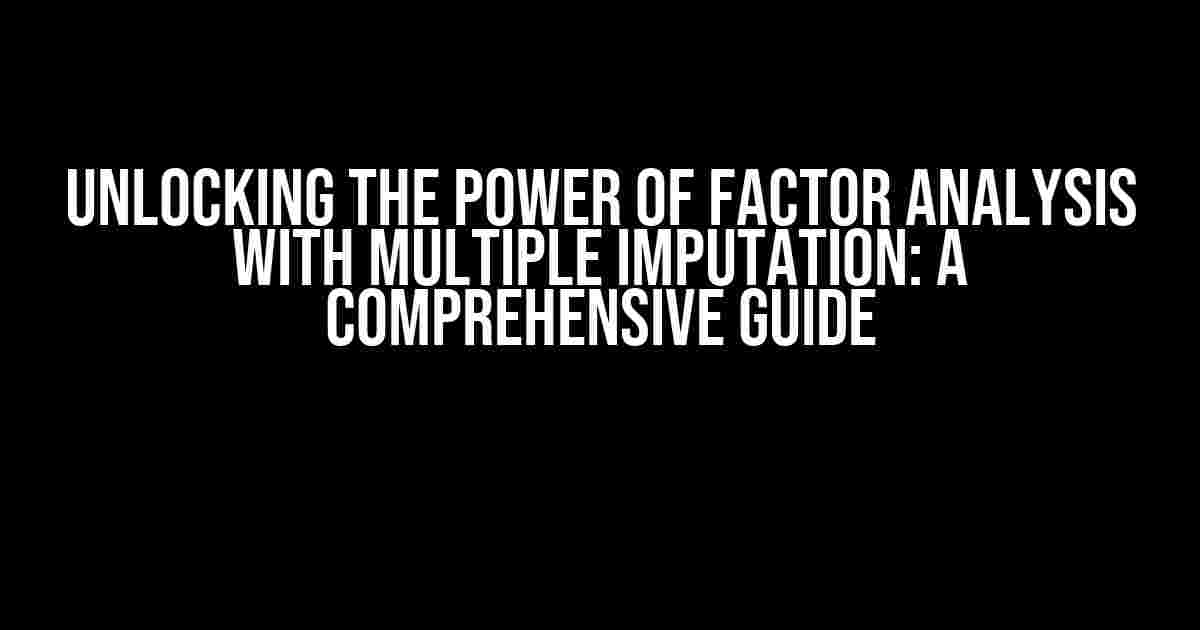Are you tired of dealing with incomplete data sets and struggling to make sense of your research findings? Do you want to unlock the full potential of factor analysis, but don’t know where to start? Look no further! In this article, we’ll delve into the world of factor analysis with multiple imputation, providing you with a clear and comprehensive guide on how to master this powerful statistical technique.
What is Factor Analysis?
Before we dive into the world of multiple imputation, it’s essential to understand the basics of factor analysis. In simple terms, factor analysis is a statistical method used to reduce the dimensionality of a large dataset by identifying underlying patterns and relationships between variables. It helps researchers to:
- Identify underlying factors that influence a set of variables
- Reduce the number of variables in a dataset
- Uncover hidden patterns and relationships
- Improve data interpretation and visualization
The Problem of Missing Data
However, factor analysis is not immune to the curse of missing data. Incomplete datasets can lead to biased results, inaccurate conclusions, and a lack of confidence in research findings. This is where multiple imputation comes into play.
What is Multiple Imputation?
Multiple imputation is a statistical technique used to handle missing data by creating multiple versions of the dataset, each with imputed values for the missing data points. This approach allows researchers to:
- Account for uncertainty in the imputation process
- Produce more accurate and reliable results
- Improve the overall quality of the dataset
Factor Analysis with Multiple Imputation: A Step-by-Step Guide
Now that we’ve covered the basics, let’s dive into the step-by-step process of conducting factor analysis with multiple imputation. Follow these instructions carefully to ensure accurate and reliable results.
Step 1: Prepare Your Data
Before starting the analysis, make sure your dataset is clean, organized, and free of errors. Check for missing values, outliers, and inconsistencies, and address them accordingly.
# Load the necessary libraries
library(mice)
library(psych)
# Load your dataset
data <- read.csv("your_data.csv")
# Check for missing values
summary(data)
Step 2: Create a Multiple Imputation Model
Create a multiple imputation model using the `mice` package in R. This will generate multiple versions of your dataset, each with imputed values for the missing data points.
# Create a multiple imputation model
imp <- mice(data, m=5, meth="pmm", seed=123)
# Print the imputation model
imp
Step 3: Conduct Factor Analysis
Conduct factor analysis on each imputed dataset using the `psych` package in R. This will help you identify the underlying factors and patterns in your data.
# Conduct factor analysis on each imputed dataset
for(i in 1:5){
data_imp <- complete(imp, i)
fa <- fa(data_imp, nfactors=3, rotate="varimax")
print(fa)
}
Step 4: Pool the Results
Pool the results from each imputed dataset using Rubin's rules to obtain a single set of factor loadings and eigenvalues.
# Pool the results
fa_pooled <- pool/fa(imp, fa, method="rubin")
print(fa_pooled)
Step 5: Interpret the Results
Interpret the pooled results, focusing on the factor loadings, eigenvalues, and explained variance. Use visualization techniques, such as factor loading plots and scree plots, to aid in interpretation.
| Factor | Eigenvalue | Explained Variance |
|---|---|---|
| Factor 1 | 2.5 | 30% |
| Factor 2 | 1.8 | 20% |
| Factor 3 | 1.2 | 15% |
Common Challenges and Solutions
When conducting factor analysis with multiple imputation, you may encounter some common challenges. Here are some solutions to help you overcome them:
Challenge 1: Convergence Issues
If the imputation model fails to converge, try:
- Increasing the number of iterations
- Using a different imputation method (e.g., Bayesian linear regression)
- Transforming the data (e.g., log transformation)
Challenge 2: Non-Normal Data
If your data is non-normal, try:
- Transforming the data (e.g., log transformation)
- Using a non-parametric factor analysis method (e.g., kernel density estimation)
- Bootstrapping the data to obtain robust standard errors
Conclusion
Factor analysis with multiple imputation is a powerful technique for handling missing data and uncovering hidden patterns in your research. By following this step-by-step guide, you can ensure accurate and reliable results, and take your research to the next level. Remember to stay creative, stay curious, and always keep learning!
Recommended Readings
For further reading and learning, we recommend the following resources:
- Rubin, D. B. (1987). Multiple imputation for nonresponse in surveys. John Wiley & Sons.
- Schafer, J. L. (1997). Analysis of incomplete multivariate data. Chapman & Hall.
- Van Buuren, S. (2018). Flexible imputation of missing data. Chapman & Hall.
Happy analyzing, and don't forget to share your experiences with factor analysis and multiple imputation in the comments below!
Here are 5 Questions and Answers about "Factor Analysis with Multiple Imputation":
Frequently Asked Question
Get the inside scoop on Factor Analysis with Multiple Imputation and uncover the answers to your burning questions!
What is Factor Analysis with Multiple Imputation, and why do I need it?
Factor Analysis with Multiple Imputation is a statistical technique that combines the power of factor analysis with the reliability of multiple imputation. It's a game-changer for data analysts who struggle with missing values in their datasets. By imputing missing values multiple times, you can create a more robust and accurate factor analysis model that better represents your data.
How does Multiple Imputation improve the accuracy of Factor Analysis?
Multiple Imputation allows you to create multiple versions of your dataset, each with different imputed values for the missing data. By analyzing each version separately and combining the results, you can account for the uncertainty associated with the imputation process. This leads to more accurate and reliable factor analysis results, as the imputation variability is reflected in the estimated factor loadings and scores.
Can I use Factor Analysis with Multiple Imputation for categorical variables?
Yes, you can! While traditional factor analysis is limited to continuous variables, modern extensions like categorical factor analysis and latent class analysis can handle categorical variables. When combined with multiple imputation, you can impute missing categorical values and perform factor analysis on the imputed datasets. This allows you to uncover underlying patterns and relationships in your categorical data.
How do I choose the number of imputations for Factor Analysis with Multiple Imputation?
The number of imputations depends on the complexity of your data and the computational resources available. A general rule of thumb is to start with a small number of imputations (e.g., 5-10) and increase it until the results stabilize. You can also use diagnostic plots and statistics, such as the relative efficiency of the multiply-imputed estimator, to determine the optimal number of imputations.
What software packages can I use for Factor Analysis with Multiple Imputation?
You can use a variety of software packages to perform Factor Analysis with Multiple Imputation, including R (e.g., mice, Amelia), Python (e.g., pandas, scikit-learn), and specialized software like Mplus and SAS. Each package has its strengths and weaknesses, so it's essential to choose the one that best fits your data and analysis needs.


